The image of John Wayne, the quintessential American cowboy, is often inseparable from his signature attire. Recently, a friend’s on-set photo sparked a conversation, highlighting a garment known in film circles as a “John Wayne shirt.” To my friend’s surprise, this wasn’t just a fan term – costume departments officially recognized the cowboy shirt with its distinctive placket front and double row of buttons as the “John Wayne shirt.” This iconic shirt, deeply associated with Wayne’s rugged persona, especially after his role as the Ringo Kid in the classic film Stagecoach, has a fascinating history that extends far beyond the silver screen. If you recall his debut as the Ringo Kid, hitchhiking in the desert, his charismatic twirl of the shotgun and captivating smile might have momentarily distracted you from noticing the shirt that would become his trademark.
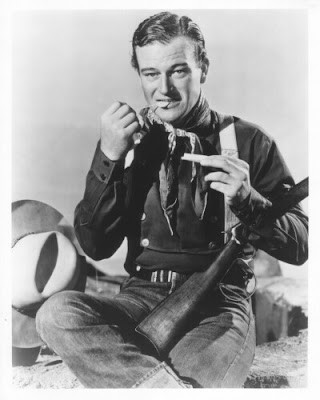 John Wayne as the Ringo Kid in Stagecoach wearing a classic placket front shirt, an early example of what would become known as the John Wayne shirt style.
John Wayne as the Ringo Kid in Stagecoach wearing a classic placket front shirt, an early example of what would become known as the John Wayne shirt style.
This style of shirt, markedly different from contemporary designs, piqued my curiosity about its origins. Intriguingly, the shirts commonly seen in Western movies weren’t mere costume creations. Cowboys genuinely wore them in real Western life. However, the roots of this iconic garment trace back even further, to the mid-19th century and an unexpected group: firefighters on both sides of the Atlantic.
The Industrial Revolution and the Rise of Mass-Produced Shirts
To understand the John Wayne shirt’s history, it’s crucial to remember that before the 19th century, all clothing was painstakingly handcrafted. The landscape of apparel production dramatically shifted in 1856 with Isaac Singer’s mass production of the Singer Sewing Machine. This invention revolutionized the industry, making factory-produced clothing, including men’s shirts, a reality. The advent of factory-made shirts arrived just in time to meet the burgeoning demand for uniforms, particularly during the American Civil War.
From Firehouses to Frontlines: The Practical Design of the Placket Front Shirt
The placket front shirt, characterized by its double row of buttons, was initially adopted by firemen. Their profession demanded a uniform that not only presented a smart appearance but also offered durability and practicality. Firefighters needed shirts that could withstand the physical demands of managing horse teams and battling blazes. Illustrations from Currier and Ives’ 1858 series on American firemen vividly depict New York firefighters sporting these robust shirts, often in red flannel.
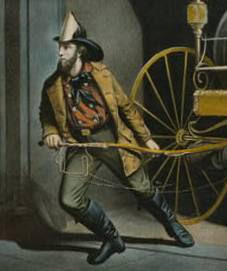 A Currier and Ives print from 1858 showcases American firemen in their distinctive placket front shirts, highlighting the early adoption of this style for practical workwear.
A Currier and Ives print from 1858 showcases American firemen in their distinctive placket front shirts, highlighting the early adoption of this style for practical workwear.
Across the Atlantic, British firefighters in the 19th century also favored the placket front shirt, often referred to as a “blouse” in uniform terminology, a term that could also denote a jacket. This transatlantic adoption underscores the shirt’s inherent functionality and appeal for demanding professions.
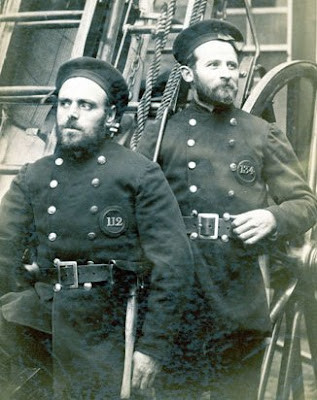 A photograph from 1890 depicting London firemen wearing placket front shirts as part of their uniform, demonstrating the international use of this practical shirt design.
A photograph from 1890 depicting London firemen wearing placket front shirts as part of their uniform, demonstrating the international use of this practical shirt design.
The American Civil War further cemented the placket front shirt’s prominence. Both Union and Confederate forces required vast quantities of mass-produced uniforms. The visually appealing and morale-boosting design of the placket front shirt with its double row of buttons proved ideal. Beyond aesthetics, the shirt was immensely practical for soldiers. The placket allowed for secure and easy access storage for personal items like tobacco pouches, letters, or food, while keeping hands free for weaponry and equipment. The reinforced placket and double buttons enhanced the shirt’s durability, crucial for the rigors of military life, providing resilience during strenuous activities like climbing, shooting, and handling horses. The “fireman’s shirt,” as it was known during the Civil War, was both handsome and highly functional.
Westward Expansion and the Cowboy Shirt Evolution
Following the Civil War, soldiers returning home took their durable shirts with them. This coincided with the great westward expansion of the United States. These robust shirts accompanied many men venturing West. Typically crafted from durable gabardine wool – the Union even used wool for undergarments, hence the term “Union suit” – these shirts were exceptionally long-lasting. In the less formal environment of the West, the practical and comfortable fireman’s shirt became a staple. It was well-suited to cowboy life, offering both comfort and convenient storage for essentials. The fireman’s shirt gradually transitioned into the quintessential cowboy shirt, favored for its durability, comfort, and practicality.
Even within the U.S. Cavalry in the post-Civil War era, some units adopted this style. Notably, George Armstrong Custer was described as wearing a version of the fireman’s shirt at the Battle of Little Bighorn in 1876. The National Park Service website details Custer’s attire:
“Custer, as he appeared at the Battle of Little Bighorn on June 25, 1876, was described by the last white people to see him alive … He wore buckskin breeches and had his buckskin coat strapped to his saddle. His shirt was a version of a “fireman’s shirt” made of lightweight wool and trimmed on the collar and cuffs with white tape.”
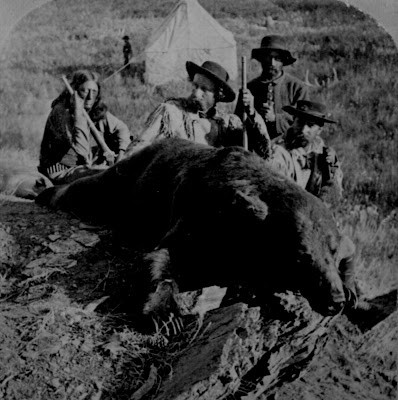 General George Armstrong Custer wearing a fireman's shirt, possibly made of buckskin, pictured during a bear hunt in the West, showcasing the shirt's use by prominent figures in Western history.
General George Armstrong Custer wearing a fireman's shirt, possibly made of buckskin, pictured during a bear hunt in the West, showcasing the shirt's use by prominent figures in Western history.
John Wayne’s Enduring Legacy and the “John Wayne Shirt”
Decades later, John Wayne, starring in numerous Westerns, particularly those depicting the U.S. Cavalry, further popularized the fireman’s shirt. His frequent on-screen appearances in this style cemented its association with the Western genre and with Wayne himself.
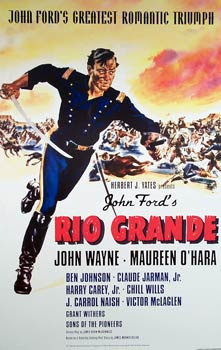 John Wayne in his trademark placket front shirt as part of his cavalry uniform, demonstrating how his film roles solidified the shirt's association with Western style.
John Wayne in his trademark placket front shirt as part of his cavalry uniform, demonstrating how his film roles solidified the shirt's association with Western style.
Wayne’s exposure to the shirt likely began during his early career at Republic Studios in the 1930s, where he starred in numerous Western “programmers.” The wranglers and stuntmen working on these films were often authentic cowboys who wore practical, readily available clothing. With the Civil War still within living memory, these shirts, worn by their fathers and uncles, were likely commonplace. During his formative decade at Republic, Wayne honed his acting style, his iconic walk, and his personal style choices, including his preferred kerchiefs and, significantly, the fireman’s shirt. He favored the shirt, recognizing its flattering fit on a broad-chested physique, a feature that undoubtedly complemented his own imposing presence.
Thus, the fireman’s shirt underwent a remarkable transformation, evolving into the “John Wayne shirt.” While anonymous firefighters initially adopted the design for its functionality, it was John Wayne who indelibly imprinted it into popular culture, making it a lasting symbol of the American West.

